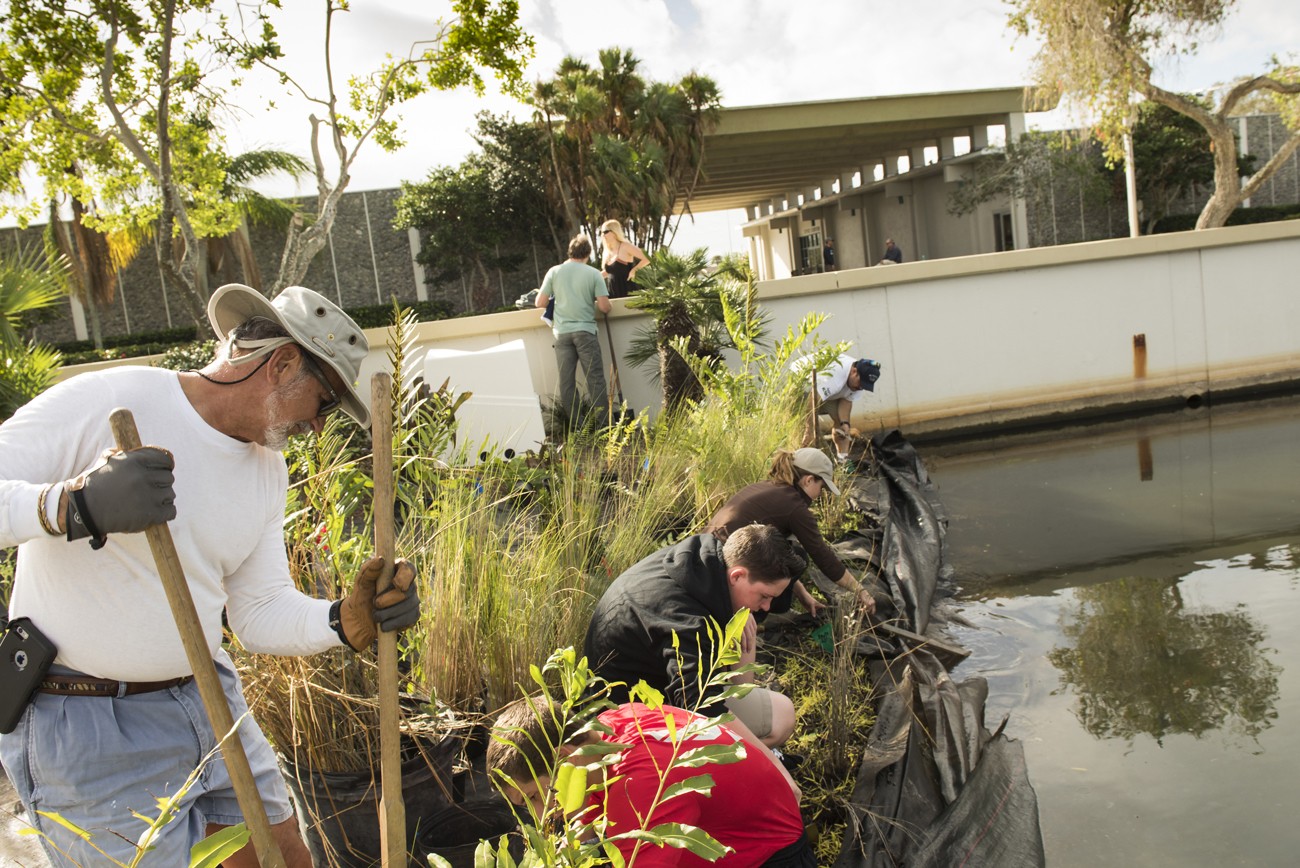
Restoring Natural Shorelines With Ocean Friendly Gardens
The Surfrider Foundation Sebastian Inlet Chapter is restoring the shore for cleaner surf and sea level rise adaptation. In Florida, the Indian River Lagoon (IRL) has made international news recently for all the wrong reasons. The once magnificent 156 mile long coast estuary is plagued by fish kills, algal blooms, polluted discharges from Lake Okeechobee, and habitat loss from development - a veritable death by a thousand cuts.
One of the major causes of these environmental problems is the overabundance of nutrients in the water. Nitrogen and phosphorous - largely from septic systems, cesspools, agriculture and residential fertilizers - are over-fertilizing many of Florida’s coastal waterways and causing environmental havoc in the form of harmful and toxic algae blooms. The Sebastian Inlet Chapter has been working to decrease and eliminate fertilizer inputs to the watershed to improve water quality and allow the ecosystem to recover. Moving the public’s view in this direction requires a lot of education, and the chapter is leading by example through engagement in restoration efforts at multiple levels. They have a board seat on the Brevard Indian River Lagoon Coalition, an advocacy group modeled after the successful Chesapeake Bay Foundation. They are also advocating for fertilizer ordinances and increased funding directed at IRL restoration.
 During 2016, the chapter also completed two Ocean Friendly Gardens (OFG) projects to restore natural shoreline habitat in partnership with local municipalities and other non-profits. The first project occurred at Ryckman Park in Melbourne Beach, the oldest beach community in Brevard County. The project was dubbed “Restore The Shore.” It was co-led by the chapter’s OFG coordinator, Bill DeLuccia, and Nichole Perna, Assistant Land Manager with Brevard’s Environmentally Endangered Lands Program. They worked every step of this project: from the conception and coordination with the town to get approval, to final design, selection of plants, and even doing the site prep work in the days just before the event.
During 2016, the chapter also completed two Ocean Friendly Gardens (OFG) projects to restore natural shoreline habitat in partnership with local municipalities and other non-profits. The first project occurred at Ryckman Park in Melbourne Beach, the oldest beach community in Brevard County. The project was dubbed “Restore The Shore.” It was co-led by the chapter’s OFG coordinator, Bill DeLuccia, and Nichole Perna, Assistant Land Manager with Brevard’s Environmentally Endangered Lands Program. They worked every step of this project: from the conception and coordination with the town to get approval, to final design, selection of plants, and even doing the site prep work in the days just before the event.
 More than 150 volunteers turned out on a beautiful, hot, Saturday morning and completely transformed the park’s shoreline from irrigated and fertilized turf grass into native plant beds. The native plants and healthy soils in these gardens filter runoff before it goes into the lagoon and don’t require any fertilizers or irrigation beyond what is provided by local rainfall. The plants also provide native habitat important to the ecosystem’s recovery and restoration. Among our volunteers were Jim Simmons, the mayor of Melbourne Beach, and Dr. Duane De Freese, the executive director of the Indian River Lagoon National Estuary Program.
More than 150 volunteers turned out on a beautiful, hot, Saturday morning and completely transformed the park’s shoreline from irrigated and fertilized turf grass into native plant beds. The native plants and healthy soils in these gardens filter runoff before it goes into the lagoon and don’t require any fertilizers or irrigation beyond what is provided by local rainfall. The plants also provide native habitat important to the ecosystem’s recovery and restoration. Among our volunteers were Jim Simmons, the mayor of Melbourne Beach, and Dr. Duane De Freese, the executive director of the Indian River Lagoon National Estuary Program.
The chapter partnered with the City of Satellite Beach and the Marine Resources Council to install a second OFG demonstration garden at the Satellite Beach City Hall. The mayor of Satellite Beach, Frank Catino, is also the dean of local inshore light tackle and fly fishing guides, and he spends a lot of time out on the water in the lagoon. Perhaps more than any other local government figure, he understands how important it is to the local economy to save the IRL. The City Hall location provided an opportunity to replace turf grass with native plants, and provide maximum visibility for residents who wish to follow the example and do their part to help the estuary.
 This time, Bill DeLuccia was able to work together with his good friend (and frequent surf buddy) Nick Sanzone on organizing this project. Nick runs the MRC’s habitat restoration program, and he and Bill did a great job. In addition to the environmental benefits they provide, the shoreline buffers are beautiful!
This time, Bill DeLuccia was able to work together with his good friend (and frequent surf buddy) Nick Sanzone on organizing this project. Nick runs the MRC’s habitat restoration program, and he and Bill did a great job. In addition to the environmental benefits they provide, the shoreline buffers are beautiful!
The chapter learned a lot of lessons that will make future OFG projects easier to install, such as the importance of keeping these projects volunteer-friendly. This is done by having some of the prep-work completed in advance. That way, when volunteers arrive on-site, the plants are ready to go in and results are easy to see quickly. Division of labor is also important. Kids are great at putting in plants, but shoveling and hauling mulch are adult jobs. The chapter looks forward to working with more communities to demonstrate how we can all become more Ocean Friendly and help prevent pollution from getting into the Indian River Lagoon.
 Photos by James Kilby of Kilbyphoto LLC
Photos by James Kilby of Kilbyphoto LLC
